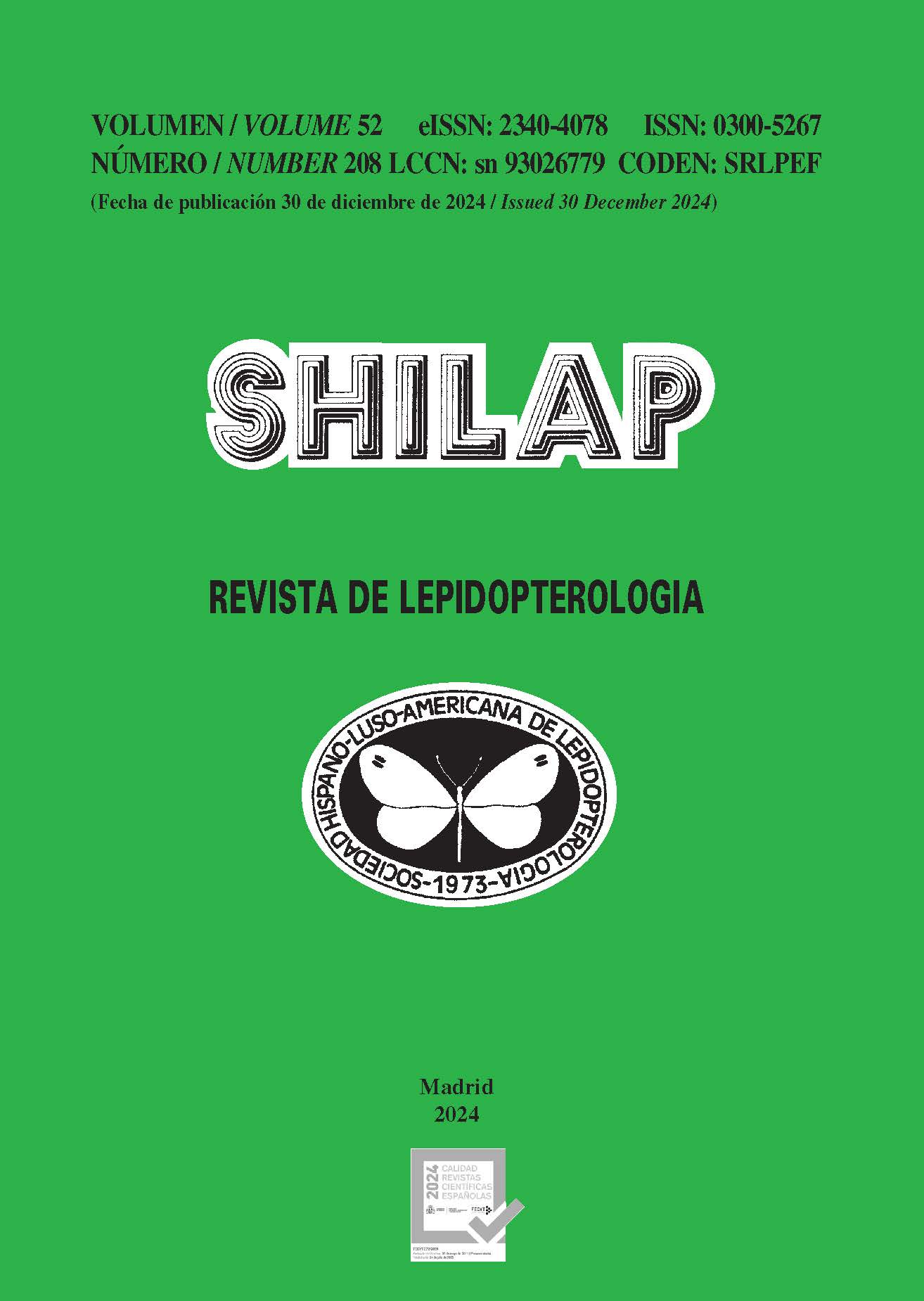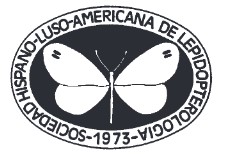Efectos del cambio climático antropogénico en la distribución potencial del género Pronophila Doubleday, [1849] en Colombia (Lepidoptera: Satyrinae, Pronophilina)
DOI :
https://doi.org/10.57065/shilap.1017Mots-clés :
Lepidoptera, Satyrinae, Pronophilina, distribución geográfica, MaxEnt, temperatura, Antropoceno, región Andina, ColombiaRésumé
El género Pronophila Doubleday, [1849] pertenece a la subtribu Pronophilina (Nymphalidae: Satyrinae) y se encuentra distribuido desde el noroeste de Argentina hasta el extremo norte de Colombia y el noreste de Venezuela, y con tan solo un representante en Centroamérica. No obstante, aún se desconocen varias características sobre la historia natural del género. Adicionalmente, diferentes procesos de perturbación antrópica han ocasionado una variación climática acelerada en los últimos años, afectando los patrones de distribución y diversidad de diferentes taxones, como es el caso de las especies del género Pronophila en Colombia, dado a que la región Andina ha sido una de las zonas más afectadas por estas actividades antrópicas en las últimas décadas. Por esta razón, el objetivo del presente estudio fue generar un modelo de distribución potencial para las especies de Pronophila en el país ante diversos escenarios de cambio climático para los años 2050 y 2070, y realizar una comparación con un modelo de distribución potencial reciente, para poder evaluar el efecto del cambio climático en la distribución del género Pronophila en el país. La proyección de los diferentes modelos se realizó en el software R usando el algoritmo MaxEnt. Los resultados demostraron que las cuatro especies de Pronophila empleadas en el modelamiento experimentaron reducciones en sus áreas de distribución potencial en los años 2050 y 2070. Finalmente, los resultados de este estudio pueden usarse para desarrollar estrategias de conservación que mitiguen la disminución de la población y las extinciones locales predichas por el cambio climático antropogénico en Lepidoptera asociados con ecosistemas montañosos del país.
Téléchargements
Statistiques globales ℹ️
|
467
Vues
|
159
Téléchargements
|
|
626
Total
|
|
Références
Anand, V., Oinam, B., & Singh, I. H. (2021). Predicting the current and future potential spatial distribution of endangered Rucervus eldii eldii (Sangai) using MaxEnt model. Environmental Monitoring and Assessment, 193(3), 147. DOI: https://doi.org/10.1007/s10661-021-08950-1
Advani, N., Parmesan, C., & Singer, M. (2019). Takeoff temperatures in Melitaea cinxia butterflies from latitudinal and elevational range limits: a potential adaptation to solar irradiance. Ecological Entomology, 44(3), 389-396. https://doi.org/10.1111/een.12714 DOI: https://doi.org/10.1111/een.12714
Aiello-Lammens, M., Boria, R., Radosavljevic, A., Vilela, B., & Anderson, R. (2015). spThin an R package for spatial thinning of species occurrence records for use in ecological niche models. Ecography, 38(5), 541-545. https://doi.org/10.1111/ecog.01132 DOI: https://doi.org/10.1111/ecog.01132
Andrade-C., M. G., Henao-Bañol, E. R., & Triviño, P. (2013). Técnicas y procesamiento para la recolección, preservación y montaje de mariposas en estudios de biodiversidad y conservación (Lepidoptera: Hesperioidea- Papilionoidea). Revista de la Academia Colombiana de Ciencias Exactas, Físicas y Naturales, 37(144), 311-325. https://doi.org/10.18257/raccefyn.12 DOI: https://doi.org/10.18257/raccefyn.12
Añazco, M. (2013). Estudio de vulnerabilidad del bambú (Guadua angustifolia) al cambio climático en la costa del Ecuador y norte Perú. Proyecto “Optimización de viviendas de bajo costo de bambú, una estrategia para adaptarse al cambio climático”. Unión Europea - Red Internacional del Bambú y Ratán.
Araujo, M. B., Thuiller, W, Williams P. H., & Reginster, I. (2005). Downscaling European species atlas distributions to a finer resolution: implications for conservation planning. Global Ecology and Biogeography, 14, 17-30. https://doi.org/10.1111/j.1466-822X.2004.00128.x DOI: https://doi.org/10.1111/j.1466-822X.2004.00128.x
Baek, H. J., Lee, J., Lee, H. S., Hyun, Y. K., Cho, C., Kwon, W. T., & Lee, J. (2013). Climate change in the 21st century simulated by HadGEM2-AO under representative concentration pathways. Asia-Pacific Journal of Atmospheric Sciences, 49, 603-618. https://doi.org/10.1007/s13143-013-0053-7 DOI: https://doi.org/10.1007/s13143-013-0053-7
Bellouin, N., Collins, W. J., Culverwell, I. D., Halloran, P. R., Hardiman, S. C., Hinton, T. J., & Roberts, M. J. (2011). The HadGEM2 family of met office unified model climate configurations. Geoscientific Model Development, 4(3), 723-757. https://doi.org/10.5194/gmd-4-723-2011 DOI: https://doi.org/10.5194/gmd-4-723-2011
Beniston, M., Diaz, H. F., & Bradley, R. S. (1997). Climatic change at high elevation sites: an overview. Climatic Change, 36, 233-252. https://doi.org/10.1023/A:1005380714349 DOI: https://doi.org/10.1023/A:1005380714349
Benito, B., & Peñas, J. (2007). Aplicación de modelos de distribución de especies a la conservación de la biodiversidad en el sureste de la Península Ibérica. GeoFocus. Revista Internacional de Ciencia y Tecnología de la Información Geográfica, 7(7), 100-119.
Carvalho, S. B., Torres, J., Tarroso, P., & Velo-Antón, G. (2019). Genes on the edge: A framework to detect genetic diversity imperiled by climate change. Global Change Biology, 25(12), 4034-4047. DOI: https://doi.org/10.1111/gcb.14740
Cheng, W., & Bonebrake, T. C. (2017). Conservation effectiveness of protected areas for Hong Kong butterflies declines under climate change. Journal of Insect Conservation, 21(4), 599-606. https://doi.org/10.1007/s10841-017-9998-7 DOI: https://doi.org/10.1007/s10841-017-9998-7
Clench, H. K. (1966). Behavioural thermoregulation in butterflies. Ecology, 47, 1021-1034. https://doi.org/10.2307/1935649 DOI: https://doi.org/10.2307/1935649
Cormont, A., Malinowska, A. H., Kostenko, O., Radchuk, V., Hemerik, L., Wallisdevries, M. F., & Verboom, J. (2011). Effect of local weather on butterfly flight behaviour, movement, and colonization: significance for dispersal under climate change. Biodiversity and Conservation, 20, 483-503. https://doi.org/10.1007/s10531-010-9960-4 DOI: https://doi.org/10.1007/s10531-010-9960-4
Cuesta, F., Muriel, P., Beck, S., Meneses, R. I., Halloy, S., Salgado, S., Ortiz, E., & Becerra, M. T. (2012). Biodiversidad y Cambio Climático en los Andes Tropicales - Conformación de una red de investigación para monitorear sus impactos y delinear acciones de adaptación. Red Gloria-Andes.
Cometti, G. (2020). El Antropoceno puesto a prueba en el campo: cambio climático y crisis de las relaciones de reciprocidad entre los q’ero de los Andes peruanos. Antipoda. Revista de Antropología y Arqueología, 38, 3-23. https://doi.org/10.7440/antipoda38.2020.01 DOI: https://doi.org/10.7440/antipoda38.2020.01
Dar, A. A., & Jamal, K. (2021). Moths as ecological indicators: A review. Munis Entomology & Zoology Journal, 16, 830-836.
Declerck, F., & Decker, M. (2009). Integrando la adaptabilidad al cambio climático a través de la biodiversidad. In C. Sepúlveda & M. Ibrahim (eds). Políticas y sistemas de incentivos para el fomento y adopción de buenas prácticas agrícolas como una medida de adaptación al cambio climático en América Central (pp. 23-29).CATIE.
Díaz-Suárez, V., Mahecha-J., O., Andrade, M. G., & Pyrcz, T. W. (2022). Perturbación antrópica afectando a los patrones de diversidad en Satyrinae de montaña Pronophilina Reuter, 1896 en un bosque altoandino en Colombia (Lepidoptera: Nymphalidae). SHILAP Revista de lepidopterología, 50(200), 709-728. https://doi.org/10.57065/shilap.263 DOI: https://doi.org/10.57065/shilap.263
Donelson, J. M., Sunday, J. M., Figueira, W. F., Gaitán-Espitia, J. D., Hobday, A. J., Johnson, C. R., & Munday, P. L. (2019). Understanding interactions between plasticity, adaptation, and range shifts in response to marine environmental change. Philosophical Transactions of the Royal Society B, 374(1768), 20180186. DOI: https://doi.org/10.1098/rstb.2018.0186
Du, Z., He, Y., Wang, H., Wang, C., & Duan, Y. (2021). Potential geographical distribution and habitat shift of the genus Ammopiptanthus in China under current and future climate change based on the MaxEnt model. Journal of Arid Environments, 184, 104328. https://doi.org/10.1016/j.jaridenv.2020.104328 DOI: https://doi.org/10.1016/j.jaridenv.2020.104328
Dudley, R. (2000). The biomechanics of insect’s flight: Form, function, evolution. Princeton University Press. https://doi.org/10.1515/9780691186344 DOI: https://doi.org/10.1515/9780691186344
Elith, J., Graham, C. H., Anderson, R. P., Dudík, M., Ferrier, S., Guisan, A., Hijmans, R. J., Huettmann, F., Leathwick, J. R., Lehmann, A., Li, J., Lohmann, L. G., Loiselle, B. A., Manion, G., Moritz, C., Nakamura, M., Nakazawa, Y., Overton, J. Mcc., Peterson, A. T., Phillips, S. J., Richardson, K. S., Scachetti Pereira, R., Schapire, R. E., Soberón, J., Williams, S., Wisz, M. S., & Zimmermann, N. E. (2006). Novel methods improve prediction of species’ distributions from occurrence data. Ecography, 29, 129-151. https://doi.org/10.1111/j.2006.0906-7590.04596.x DOI: https://doi.org/10.1111/j.2006.0906-7590.04596.x
Elith, J., Kearney, M., & Phillips, S. (2010). The art of modelling range-shifting species. Methods in ecology and evolution, 1(4), 330-342. https://doi:10.1111/j.2041-210X.2010.00036.x DOI: https://doi.org/10.1111/j.2041-210X.2010.00036.x
Elith, J., Steven J., Hastie, T., Dudík, M., Yung, E., &Yates, C. (2011). A statistical explanation of MaxEnt for ecologists. Diversity and Distributions, 17, 43-57. https://doi.org/10.1111/j.1472-4642.2010.00725.x DOI: https://doi.org/10.1111/j.1472-4642.2010.00725.x
Equihua, M., Hernández, A., Pérez, O., Benítez, G., & Ibañez, S. (2016). Cambio global: el Antropoceno. Universidad Autónoma del Estado de México Toluca, México. Ciencia Ergo Sum, 23(1), 67-75.
ESRI (2016). ArcGIS [software GIS]. Version 10.5. Redlands, CA: Environmental Systems Research Institute, Inc. Esri Press.
Fielding, A., & Bell, J. (1997). A review of methods for the assessment of prediction errors in conservation presence/absence models. Environmental Conservation, 24(1), 38-49. https://doi.org/10.1017/S0376892997000088 DOI: https://doi.org/10.1017/S0376892997000088
Fleishman, E., Austin, G. T., Bussard, P. F., & Murphy, D. D. (1999). A comparison of Butterfly communities in native and agricultural habitats in the Great Basin, USA. Biological Conservation, 89, 209-218. https://doi.org/10.1016/S0006-3207(98)00152-9 DOI: https://doi.org/10.1016/S0006-3207(98)00152-9
Fox, J. W., Vasseur, D., Cotroneo, M., Guan, L., & Simon, F. (2017). Population extinctions can increase metapopulation persistence. Nature ecology & evolution, 1(9), 1271-1278. DOI: https://doi.org/10.1038/s41559-017-0271-y
Gaitán-Espitia, J. D., & Hobday, A. J. (2021). Evolutionary principles and genetic considerations for guiding conservation interventions under climate change. Global Change Biology, 27(3), 475-488. https://doi.org/10.1111/gcb.15359 DOI: https://doi.org/10.1111/gcb.15359
García-Pérez, J. F., Ospina-López, L. A., Villa-Navarro. F. A., & Reinoso-Flórez., G. (2007). Diversidad y distribución de mariposas Satyrinae (Lepidoptera: Nymphalidae) en la cuenca del río Coello, Colombia. Revista de Biología Tropical, 55, 645-653. https://doi.org/10.15517/rbt.v55i2.6039 PMid:19069774 DOI: https://doi.org/10.15517/rbt.v55i2.6039
Gebrewahid, Y., Abrehe, S., Meresa, E., Eyasu, G., Abay, K., Gebreab, G., & Darcha, G. (2020). Current and future predicting potential areas of Oxytenanthera abyssinica (A. Richard) using MaxEnt model under climate change in Northern Ethiopia. Ecological processes, 9(1), 1-15. https://doi.org/10.1186/s13717-019-0210-8 DOI: https://doi.org/10.1186/s13717-019-0210-8
Greeney, H. F., Pyrcz, T. W., Devries, P. J. & Dyer, L. A. (2009). The early stages of Pedaliodes poesia (Hewitson, 1862) in Eastern Ecuador (Lepidoptera: Satyrinae: Pronophilini). Journal of Insect Science, 9, 1-8. https://doi.org/10.1673/031.009.3801 PMid:19619012 PMCid: PMC3011897 DOI: https://doi.org/10.1673/031.009.3801
Gonda, C. (2020). Cambio Climático y Biodiversidad en los Andes Tropicales Fundación Ambiente y Recursos Naturales (FARN).
Haraway, D. (2015). Anthropocene, Capitalocene, Plantacionocene, Chthulucene: Making kin. Environmental Humanities, 6, 159-165. https://doi.org/10.1215/22011919-3615934 DOI: https://doi.org/10.1215/22011919-3615934
Hawkins, B. A., Field, R., Cornell, H. V., Currie, D. J., Guégan, J.-F., Kaufman, D. M., Kerr, J. T., Mittelbach, G. G., Oberdorff, T., O`Brien, E. M., Porter, E. E., & Turner, J. R. G. (2003). Energy, water, and broad-scale geographic patterns of species richness. Ecology, 84(12), 3105-3117. https://doi.org/10.1890/03-8006 DOI: https://doi.org/10.1890/03-8006
He, Q., & Silliman, B. R. (2019). Climate change, human impacts, and coastal ecosystems in the Anthropocene. Current Biology, 29(19), R1021-R1035. DOI: https://doi.org/10.1016/j.cub.2019.08.042
Herzog, S. K., Jorgensen, P., Martínez, S., & Tiessen, H. (2012). Patrones regionales de diversidad y endemismo en las plantas vasculares. In F. Cuesta, P. Muriel, S. Beck, R.I. Meneses, S. Halloy, S. Salgado, E. Ortiz & M.T. Becerra (ed.). Cambio Climático y Biodiversidad en los Andes Tropicales (pp. 180). Red Gloria-Andes. Hijmans, R., Cameron, S., Parra, J., Jones, P., & Jarvis, A. (2005). Very high-resolution interpolated climate surfaces of global land areas. International Journal of Climatology, 25, 1965-1978. https://doi.org/10.1002/joc.1276 DOI: https://doi.org/10.1002/joc.1276
Hijmans, R., & Graham, C. (2006). The ability of climate envelope models to predict the effect of climate change on species distributions. Global Change Biology, 12, 2272-2281. https://doi.org/10.1111/j.1365-2486.2006.01256.x DOI: https://doi.org/10.1111/j.1365-2486.2006.01256.x
Hijmans, R. J., Phillips, S., Leathwick, J., Elith, J., & Hijmans, M. R. J. (2017). Package ‘dismo’. Circles, 9(1), 1-68.
Hickling, R., Roy, D. B., Hill, J., Fox, R., & Thomas, C. (2006). The distributions of a wide range of taxonomic groups are expanding polewards. Global Change Biology, 12(3), 450-455. https://doi.org/10.1111/j.1365-2486.2006.01116.x DOI: https://doi.org/10.1111/j.1365-2486.2006.01116.x
IPCC (2013). Summary for Policymakers. In T. F. Stocker, D. Qin, G.-K. Plattner, M. Tignor, S. Allen, J. Boschung, & P. Midgley (Eds.), Climate change 2013: The physical science basis. Contribution of Working Group I to the Fifth Assessment Report of the Intergovernmental Panel on Climate Change. Cambridge University Press.
IPCC (2014). Climate change 2014: Mitigation of climate change. Contribution of working group 3 to the fifth assessment report of the intergovernmental panel on climate change. In O. Edenhofer,R. Pichs-Madruga, Y. Sokona, E. Farahani, S. Kadner, K., Seyboth, J. Minx (Eds.). Cambridge University Press
James, S. A., Clearwater, M. J., Meinzer, F. C., & Goldstein, G. (2002). Heat dissipation sensors of variable length for the measurements of sap flow in trees with deep sapwood. Tree Physiology, 22, 277-283. https://doi.org/10.1093/treephys/22.4.277 PMid:11874724 DOI: https://doi.org/10.1093/treephys/22.4.277
Jubb, I., Canadell, P., & Dix, M. (2013). Representative concentration pathways (RCPs). Australian Government.
Kocsis, M., & Hufnagel, L. (2011). Impacts of climate change on Lepidoptera species and communities. Applied Ecology and Environmental Research, 9, 43-72. https://doi.org/10.15666/aeer/0901_043072 DOI: https://doi.org/10.15666/aeer/0901_043072
Lamont, B. B., & Connell, S. W. (1996). Biogeography of Banksia in southwestern Australia. Journal of Biogeography, 23, 295-309. https://doi.org/10.1046/j.1365-2699.1996.00027.x DOI: https://doi.org/10.1046/j.1365-2699.1996.00027.x
Laurente, M. (2015). Efectos del cambio climático en la distribución del Cedro (Cedrela odorata L.) en la Amazonia Peruana. The Biologist, 13(2), 213-224.
Lemoine, N., Bauer, B., Peintinger, M., & Böhning-Gaese, K. (2007). Effects of Climate and Land-Use Change on Species Abundance in a Central European Bird Community. Conservation Biology, 21, 495-503. https://doi.org/10.1111/j.1523-1739.2006.00633.x PMid:17391199 DOI: https://doi.org/10.1111/j.1523-1739.2006.00633.x
Li, Y., Li, M., Li, C., & Liu, Z. (2020). Optimized maxent model predictions of climate change impacts on the suitable distribution of Cunninghamia lanceolata in China. Forests, 11(3), 302. DOI: https://doi.org/10.3390/f11030302
Lobo, J. M. (2011). Vulnerabilidad de las áreas protegidas y de zonas de interés para la biodiversidad ante el cambio climático. In P. Álvarez-Uría & J. L. De La Cruz (Coords.). Biodiversidad en España. Base de la Sostenibilidad ante el Cambio Global. Observatorio de la Sostenibilidad de España, Ministerio de Medio Ambiente y Medio Rural y Marino.
Locatelli, B., Kanninen, M., Brockhaus, M., Colfer, C. J. P., Murdiyarso, D., & Santoso, H. (2009). Ante un futuro incierto: cómo se pueden adaptar los bosques y las comunidades al cambio climático. Perspectivas forestales, 5, 1-92. CIFOR.
Locatelli, B. & Kanninen, M. (2010). Servicios ecosistémicos y adaptación al cambio climático. In R. Vignola, I. Pablo, C. Martínez-Alonso & B. Locatelli. Adaptación al cambio climático y servicios ecosistémicos en América Latina (11-20). Centro Agronómico Tropical de Investigación y Enseñanza (CATIE).
Lovejoy, T. D. (2008). Climate Change and Biodiversity. Revue scientifique et technique (International Office of Epizzotics), 27, 331-338. https://doi.org/10.20506/rst.27.2.1808 DOI: https://doi.org/10.20506/rst.27.2.1808
Maciel-Mata, C. A., Manríquez-Morán, N., Octavio-Aguilar, P., & Sánchez-Rojas, G. (2015). El área de distribución de las especies: revisión del concepto. Acta universitaria, 25(2), 3-19. https://doi.org/10.15174/au.2015.690 DOI: https://doi.org/10.15174/au.2015.690
Mahecha-Jiménez, O. J., Dumar-Rodríguez, J. C., & Pyrcz, T. W. (2011). Efecto de la fragmentación del hábitat sobre las comunidades de Lepidoptera de la tribu Pronophilini a lo largo de un gradiente altitudinal en un bosque andino en Bogotá (Colombia) (Lepidoptera: Nymphalidae, Satyrina). SHILAP Revista de lepidopterología, 39(153), 117-126.
Mahecha, O., Garlacz, R., Andrade, M. G; Prieto, C., & Pyrcz, T. W. (2019). Island biogeography in continental areas: inferring dispersal based on distributional patterns of Pronophilina butterflies (Nymphalidae: Satyrinae) in the north Andean massifs. Revista mexicana de biodiversidad, 90, e902796. https://doi.org/10.22201/ib.20078706e.2019.90.2796 DOI: https://doi.org/10.22201/ib.20078706e.2019.90.2796
Mahecha-J, O., Triviño, P., Andrade-C, M. G., & Pyrcz, T. W. (2021). Two new species of Manerebia Staudinger from paramo habitat in the Colombian Eastern Cordillera of the Andes (Lepidoptera: Nymphalidae, Satyrinae, Pronophilina). Zootaxa, 4970(2), 293302. DOI: https://doi.org/10.11646/zootaxa.4970.2.3
Martín J. L., Bethencourt, J., & Cuevas-Agulló, E. (2011). Evolución el calentamiento global en Tenerife. Tendencias desde 1944 en las temperaturas máximas y mínimas anuales. Proyecto ClimaImpacto del programa de Cooperación Translacional Madeira-Azores-Canarias 2007-2011.
Mateo, G. R., Felicísimo, A. M., & Muñoz, J. (2011). Modelos de distribución de las especies: una revisión sintética. Revista Chilena de Historia Natural, 84(2), 217-240. https://doi.org/10.4067/S0716-078X2011000200008 DOI: https://doi.org/10.4067/S0716-078X2011000200008
Merrill, R. M., Gutiérrez, D., Lewis, O. T., Gutiérrez, J., Díez, S. B., & Wilson, R. J. (2008). Combined effects of climate and biotic interactions on the elevational range of a phytophagous insect. Journal of Animal Ecology, 77, 145-155. https://doi.org/10.1111/j.1365-2656.2007.01303.x PMid:18177334 DOI: https://doi.org/10.1111/j.1365-2656.2007.01303.x
Mestres, F., Zivanovic, G., & Arenas, C. (2015). ¿Cómo se adaptan los organismos al cambio climático? las inversiones cromosómicas de “Drosophila subobscura”: el caso de las poblaciones de Serbia. Mètode Revista de difusión de la Investigación, 88, 36-43.
Miller, D. G., Lane, J., & Senock, R. (2011). Butterflies as potential bioindicators of primary rainforest and oil palm plantation habitats on New Britain, Papua New Guinea. Pacific Conservation Biology, 17, 149- 159. https://doi.org/10.1071/PC110149 DOI: https://doi.org/10.1071/PC110149
Molina-Martínez, A., León-Cortes, J. L., Regan, M., Lewis, O. T., Navarrete, D., Caballero, U., & Luis-Martínez, A. (2016). Changes in butterfly distributions and species assemblages on a Neotropical Mountain range in response to global warming and anthropogenic land use. Diversity Distribution, 21, 1085-1098. https://doi.org/10.1111/ddi.12473 DOI: https://doi.org/10.1111/ddi.12473
Montero, F. A., & Ortiz-Pérez, M. (2012). Estados inmaduros e historia natural de algunas especies de la subtribu Pronophilina (Nymphalidae: Satyrinae) presentes en el Páramo del Tablazo–Colombia. II. Lymanopoda schmidti Adams 1986. Tropical Lepidoptera Research, 22(1), 32-41.
Montero, F. A., & Ortiz-Pérez, M. (2013). Estados inmaduros e historia natural de algunas especies de la subtribu Pronophilina (Nymphalidae: Satyrinae) presentes en el páramo del tablazo–Colombia. ii. Neopedaliodes zipa (Adams 1986). Tropical Lepidoptera Research, 54-61.
Nieto-Sánchez, S., Gutiérrez, D., & Wilson, R. J. (2015). Long-term change and spatial variation in butterfly communities over an elevation gradient driven by climate, buffered by habitat. Diversity Distribution, 21, 950-961. https://doi.org/10.1111/ddi.12316 DOI: https://doi.org/10.1111/ddi.12316
Olarte-Quiñonez, C. A., Carrero-Sarmiento, D., Viloria, Á. L., & Ríos-Málaver, I. C. (2021). Patrones de diversidad de las mariposas de la subtribu Pronophilina (Lepidoptera: Nymphalidae: Satyrinae) en un gradiente altitudinal del Cerro de Tierra Negra, Cordillera Oriental, Norte de Santander, Colombia. Boletín Científico. Centro de Museos. Museo de Historia Natural, 25(2), 197-218. DOI: https://doi.org/10.17151/bccm.2021.25.2.12
Olson, S. K., Smithwick, E. A., Lucash, M. S., Scheller, R. M., Nicholas, R. E., Ruckert, K. L., & Caldwell, C. M. (2021). Landscape-scale Forest reorganization following insect invasion and harvest under future climate change scenarios. Ecosystems, 1-19. DOI: https://doi.org/10.1007/s10021-021-00616-w
Peterson, A. T. (2001). Predicting species geographic distributions based on ecological niche modeling. The Condor, 103(3), 599-605. https://doi.org/10.1093/condor/103.3.599 DOI: https://doi.org/10.1093/condor/103.3.599
Peterson, A. T. (2003). Predicting the geography of species’ invasions via ecological niche modeling. Quarterly Review of Biology, 78, 419-433. https://doi.org/10.1086/378926 PMid:14737826 DOI: https://doi.org/10.1086/378926
Peterson, D. P., Rieman, B. E., Dunham, J. B., Fausch, K. D., & Young, M. K. (2008). Analysis of trade-offs between the threat of invasion by nonnative brook trout (Salvelinus fontinalis) and intentional isolation for native west slope cutthroat trout (Oncorhynchus clarkiilewisi). Canadian Journal of Fisheries and Aquatic Sciences, 65(4), 557-573. https://doi.org/10.1139/f07-184 DOI: https://doi.org/10.1139/f07-184
Phillips, S. J., Anderson, R. P., & Schapire, R. E. (2006). Maximum entropy modeling of species geographic distributions. Ecological Modeling, 190, 231-259. https://doi.org/10.1016/j.ecolmodel.2005.03.026 DOI: https://doi.org/10.1016/j.ecolmodel.2005.03.026
Pyrcz, T. W., & Wojtusiak, J. (1999). Mariposas de la tribu Pronophilini de la Reserva forestal Tambito, Cordillera occidental, Colombia. Segunda parte. Patrones de distribución altitudinal (Lepidoptera: Nymphalidae, Satyrinae). SHILAP Revista de lepidopterología, 27(106), 203-213.
Pyrcz, T. W. (2000). Contributions to the knowledge of Ecuadorian Pronophilini. Part IV. New taxa of Pronophila Doubleday (Lepidoptera: Nymphalidae: Satyrinae). Genus, 11(1), 69-86.
Pyrcz, T. W., & Wojtusiak, J. (2002). The vertical distribution of pronophiline butterflies (Nymphalidae, Satyrinae) along an elevational transect in Monte Zerpa (Cordillera de Mérida, Venezuela) with remarks on their diversity and parapatric distribution. Global Ecology and Biogeography, 11, 211-221. https://doi.org/10.1046/j.1466-822X.2002.00285.x DOI: https://doi.org/10.1046/j.1466-822X.2002.00285.x
Pyrcz, T. W. (2004). Notas taxonómicas sobre el género Pronophila Doubleday con la descripción de cuatro nuevas subespecies de Pronophila unifasciata Lathy (Nymphalidae: Satyrinae: Pronophilini). Boletín Museo de Historia Natural, 6(30), 233-244.
Pyrcz, T. W., & Viloria, A. L. (2007). Erebiine and Pronophiline Butterflies of the Serranía del Tama, Venezuela-Colombia Border (Lepidoptera: Nymphalidae: Satyrinae). Tropical Lepidoptera, 15(1-2), 18-52.
Pyrcz, T. W., Wojtusiak, J., & Garlacz, R. (2009). Diversity and distribution patterns of Pronophilina butterflies (Lepidoptera: Nymphalidae: Satyrinae) along an altitudinal transect in northwestern Ecuador. Neotropical Entomology, 38, 716-726. https://doi.org/10.1590/S1519-566X2009000600003 PMid:20098916 DOI: https://doi.org/10.1590/S1519-566X2009000600003
Pyrcz T., Cerdeña, J., & Huamani, E. (2013). Systematics, bionomics, and zoogeography of high Andean pedaliodines. Part 14: Two new species of Pedaliodes Butler from the Huancabamba Deflection in southern Ecuador and northern Peru (Lepidoptera: Nymphalidae: Satyrinae). Genus, 24(2), 131-141.
Pyrcz, T. W., Clavijo, A., Uribe, S., Marín, M. A., Álvarez, C. F. y Zubek, A. (2016). Páramo de Belmira as an important centre of endemism in the northern Colombian Andes: New evidence from Pronophilina butterflies (Lepidoptera: Nymphalidae, Satyrinae, Satyrini). Zootaxa, 4179(1), 77-102. https://doi.org/10.11646/zootaxa.4179.1.3 DOI: https://doi.org/10.11646/zootaxa.4179.1.3
Pyrcz, T. W., Lorenc-Brudecka, J., Zubek, A., Prieto, C., Boyer, P., Florczyk, K., & Lachowska-Cierlik, D. (2019). Considerations on the taxonomy of the genus Arhuaco Adams and Bernard 1977, and its relationships with the genus Pronophila Doubleday [1849] (Nymphalidae, Satyrinae). Neotropical entomology, 48, 302-313. DOI: https://doi.org/10.1007/s13744-018-0641-4
Pyrcz, T. W., Zubeck, A., Boyer, P., Nakamura, I., Waclawik, B., & Florczyk, K. (2020). Revisional notes on the cloud forest butterfly genus Oxeoschistus Butler in Central America (Lepidoptera: Nymphalidae: Satyrinae). Neotropical Entomology, 49, 392-411. http://dx.doi.org/10.1007/s13744-019-00757-7. DOI: https://doi.org/10.1007/s13744-019-00757-7
Quesada-Quirós, M., Acosta-Vargas, L. G., Arias-Aguilar, D., & Rodríguez-González, A. (2016). Modelación de nichos ecológicos basado en tres escenarios de cambio climático para cinco especies de plantas en zonas altas de Costa Rica. Revista Forestal Mesoamericana Kurú, 14(34), 1-12. https://doi.org/10.18845/rfmk.v14i34.2991 DOI: https://doi.org/10.18845/rfmk.v14i34.2991
R Core Team (2023). R: A language and environment for statistical computing. R Foundation for Statistical Computing. https://www.R-project.org/
Rajpoot, R., Adhikari, D., Verma, S., Saikia, P., Kumar, A., Grant, K. R., & Khan, M. L. (2020). Climate models predict a divergent future for the medicinal tree Boswellia serrata Roxb. in India. Global Ecology and Conservation, 23, e01040. https://doi.org/10.1016/j.gecco.2020.e01040 DOI: https://doi.org/10.1016/j.gecco.2020.e01040
Riahi, K., Rao, S., Krey, V., Cho, C., Chirkov, V., Fischer, G., Kindermann, G., Nakicenovic, N., & Rafaj, P. (2011). RCP 8.5: A scenario of comparatively high greenhouse gas emissions. Climatic Change, 109, 33-57. https://doi.org/10.1007/s10584-011-0149-y DOI: https://doi.org/10.1007/s10584-011-0149-y
Rödder, D., Schmitt, T., Gros, P., Ulrich, W., & Habel, J. C. (2021). Climate change drives mountain butterflies towards the summits. Scientific Reports, 11(1), 14382. DOI: https://doi.org/10.1038/s41598-021-93826-0
Romero-Centeno, R., Adams, D. K., Amador-Astúa, J. A., Castro, C. L., Cavazos-Pérez, M. T., Garduño-López, R., Lizarraga-Celaya, C., Mendoza-Castro, V. M., & Pavia-López, E. (2016). Fenómenos climáticos y su relevancia para el cambio climático regional futuro. In C. Gay García & J. C. Rueda Abad. Reporte Mexicano de Cambio Climático. Grupo I Bases científicas. Modelos y modelación (pp. 219-246). Universidad Nacional Autónoma de México.
Romo, H., Sanabria, P., & García-Barros, E. (2013). Predicción de los impactos del cambio climático en la distribución sobre las especies de Lepidoptera. El caso del género Boloria Moore, 1900 en la Península Ibérica (Lepidoptera: Nymphalidae). SHILAP Revista de lepidopterología, 41(162), 267-286.
Russo, R. O., & Kohlmann, B. (2013). Cambio Climático: efectos sobre la Biodiversidad. Universidad La Salle.
Särkinen, T., Toby, R., Lavin, M., Simon, M., & Hughes, C. (2011). Evolutionary islands in the Andes: persistence and isolation explain high endemism in Andean dry tropical forests. Journal of Biogeography, 39(5), 884-900. https://doi.org/10.1111/j.1365-2699.2011.02644.x DOI: https://doi.org/10.1111/j.1365-2699.2011.02644.x
Stranges, S., Cuervo-Robayo, A. P., Martínez-Meyer, E., Morzaria-Luna, H. N., & Reyes-Bonilla, H. (2019). Distribución potencial bajo escenarios de cambio climático de corales del género Pocillopora (Anthozoa: Scleractinia) en el Pacífico oriental tropical. Revista mexicana de biodiversidad, 90, 1-16. https://doi.org/10.22201/ib.20078706e.2019.90.2696 DOI: https://doi.org/10.22201/ib.20078706e.2019.90.2696
Swets, J. A. (1988). Measuring the accuracy of diagnostic systems. Science, 240(4857), 1285-1293. DOI: https://doi.org/10.1126/science.3287615
Taylor, K. E., Stouffer, R. J., & Meehl, G. A. (2012). An overview of CMIP5 and the experiment design. Bulletin of the American Meteorological Society, 93(4), 485-498. https://doi.org/10.1175/BAMS-D-11-00094.1 DOI: https://doi.org/10.1175/BAMS-D-11-00094.1
Torres-Vila, L., Stockel, J., & Rodríguez, M. (1996). Efecto de la indisponibilidad de agua sobre el potencial biótico de la polilla del racimo Lobesia botrana Den. y Schiff. (Lepidoptera: Tortricidae). Boletín de Sanidad Vegetal. Plagas, 22, 443-444.
Turvey, S. T., & Crees, J. J. (2019). Extinction in the Anthropocene. Current Biology, 29(19), R982-R986. Uribe, E. (2015). El cambio climático y sus efectos en la biodiversidad en América Latina. Comisión Económica para América Latina y el Caribe (CEPAL). DOI: https://doi.org/10.1016/j.cub.2019.07.040
Viloria, A. (2008). Mariposa blanca del páramo, Lymanopoda paramera. In J. P. Rodríguez & F. Rojas Suárez (Eds.). Libro Rojo de la Fauna Venezolana (p. 227). Provita y Shell Venezuela, S. A.
Viloria, A. L., Pyrcz, T. W., & Orellana, A. (2010). A survey of the Neotropical montane butterflies of the subtribe Pronophilina (Lepidoptera, Nymphalidae) in the Venezuelan Cordillera de la Costa. Zootaxa, 2622, 1-41. https://doi.org/10.11646/zootaxa.2622.1.1 DOI: https://doi.org/10.11646/zootaxa.2622.1.1
Wei, B., Wang, R., Hou, K., Wang, X., & Wu, W. (2018). Predicting the current and future cultivation regions of Carthamus tinctorius L. using MaxEnt model under climate change in China. Global Ecology and Conservation, 16, e00477. https://doi.org/10.1016/j.gecco.2018.e00477 DOI: https://doi.org/10.1016/j.gecco.2018.e00477
Wang, R., Li, Q., He, S., Liu, Y., Wang, M., & Jiang, G. (2018). Modeling and mapping the current and future distribution of Pseudomonas syringae pv. actinidiae under climate change in China. PloS one, 13(2), e0192153. https://doi.org/10.1371/journal. pone.0192153 DOI: https://doi.org/10.1371/journal.pone.0192153
Wickman, P. (2009). Thermoregulation and habitat use in butterflies. In J. Settele, T. Shreeve, M. Konvicka & H. Van Dyck, eds. Ecology of butterflies in Europe (pp. 55-61). Cambridge University Press.
Xianli, Z., Yingcun, X., & Howell, T. (2018). Jackknife approach to the estimation of mutual information. PNAS, 115(40), 9956-9961. https://doi.org/10.1073/pnas.1715593115 PMid:30224466 PMCid:PMC6176556 DOI: https://doi.org/10.1073/pnas.1715593115
Zenker, M., De Vries, P., Penz, C., Teston, J., Freitas, A. V. L., & Pie, M. (2015). Diversity and composition of Arctiinae moth assemblages along elevational and spatial dimensions in Brazilian Atlantic Forest. Journal of Insect Conservation, 19(1), 129-140. https://doi.org/10.1007/s10841-015-9753-x DOI: https://doi.org/10.1007/s10841-015-9753-x
Téléchargements
Publiée
Comment citer
Numéro
Rubrique
Licence
(c) Tous droits réservés Ana María Murillo-P., Oscar Mahecha-J., Vanessa Díaz-S., Miguel Gonzalo Andrade-C., Tomasz W. Pyrcz 2024

Ce travail est disponible sous la licence Creative Commons Attribution 4.0 International .
L'auteur conserve ses droits de marque et de brevet sur tout procédé ou procédure figurant dans l'article.
L'auteur conserve le droit de partager, distribuer, exécuter et communiquer publiquement l'article publié dans SHILAP Revista de lepidopterología, avec une reconnaissance initiale de sa publication dans SHILAP Revista de lepidopterología.
L'auteur conserve le droit de procéder à une publication ultérieure de son travail, de l'utilisation de l'article à sa publication dans un livre, à condition d'indiquer sa publication initiale dans le SHILAP Revista de lepidopterología.
Chaque soumission à SHILAP Revista de lepidopterología doit être accompagnée d'une acceptation des droits d'auteur et de la mention de la paternité. En les acceptant, les auteurs conservent le droit d'auteur de leur travail et acceptent que l'article, s'il est accepté pour publication par le SHILAP Revista de lepidopterología, soit autorisé à être utilisé et distribué sous une licence "Creative Commons Attribution 4.0 International" (CC BY 4.0) ce qui permet une utilisation, une distribution et une reproduction sans restriction sur tout support, à condition que l'auteur et la source originale soient mentionnés.
Vous pouvez lire ici les informations de base et le texte légal de la licence. L'indication de la licence CC BY 4.0 doit être expressément mentionnée de cette manière lorsque cela est nécessaire.
À partir de 2022, le contenu de la version imprimée et numérique est soumis à une licence d'utilisation et de distribution "Creative Commons Attribution 4.0 International" (CC BY 4.0), ce qui permet une utilisation, une distribution et une reproduction sans restriction sur tout support, à condition que l'auteur et la source originale soient mentionnés.
Le contenu antérieur de la revue a été publié sous une licence de droit d'auteur traditionnelle; toutefois, les archives sont disponibles en libre accès.
Lors de l'utilisation du contenu de SHILAP Revista de lepidopterología publié avant l'année 2022, y compris les figures, les tableaux ou tout autre matériel sous forme imprimée ou électronique appartenant aux auteurs des articles, les auteurs doivent obtenir l'autorisation du détenteur des droits d'auteur. Les responsabilités légales, financières et pénales à cet égard incombent à l'auteur ou aux auteurs.
En application du Principe de Priorité du Code international de nomenclature zoologique, aucune autre version que celle publiée par l'éditeur ne peut être déposée dans des dépôts, des sites web personnels ou similaires.





























